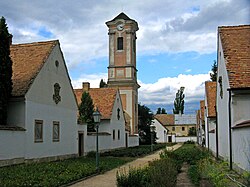Oroszlány
| Oroszlány | ||
|---|---|---|
 
Hermites'Houses (Remeteházak) in the former Camaldolese monastery in Majkpuszta
|
||
|
||
| Location of Oroszlány | ||
| Coordinates: 47°29′01″N 18°18′46″E / 47.48361°N 18.31272°E | ||
| Country |
|
|
| County | Komárom-Esztergom | |
| Area | ||
| • Total | 75.86 km2 (29.29 sq mi) | |
| Population (2004) | ||
| • Total | 20,034 | |
| • Density | 264.09/km2 (684.0/sq mi) | |
| Time zone | CET (UTC+1) | |
| • Summer (DST) | CEST (UTC+2) | |
| Postal code | 2840 | |
| Area code(s) | 34 | |
Oroszlány (archaic form of oroszlán, means lion; German: Ohreslahn) is a city in Hungary, Komárom-Esztergom county, Central Transdanubia region, located on the North-West flanks of the Vértes Mountains. It has a population of 20.487. The main tourist attraction of the town is the 18th-century Camaldolese monastery of Majk.
The name of the town comes from the lion on the coat of arms of the Csák family that founded it.
There was a settlement in Környe near the town already during the Roman era (Quirinum), but there are also traces from even earlier from the Avar people whose presence is attested by the cemetery remains found in 1957 and 1973.
Its first mention is from 1383 when the name Oroszlankew (modern Hungarian: oroszlánkő meaning lion/lion's stone) appears and then it is mentioned in a 15th-century deed as Possesio Orozlankew of the Csák family.
In 1536 the "Castle of Oroszlánkő" is mentioned and then it is not mentioned any more among the populated settlements during the time of Turkish occupation. What is certain is that the Turks set to fire the castles of Tata, Gesztes and Vitány in their 1543 campaign so the castle of Oroszlánkő may also have shared their fate.
In the second half of the 16th and in the 17th century the castle and its surroundings are totally uninhabited that is the contemporary name Pusztaoroszlánkő (=barren lion's stone). The area was repopulated by the then lords of the area, the Esterházys who settled Slovaks from the Pozsony (today Bratislava), Nitra and Trencin counties to the empty land. At this time, the ruins of the castle were still there but they were carried away piece by piece for building houses.
After the fall of the Rákóczi's War for Independence, the lord of the land, Antal Esterházy followed his ruler to exile so his land fell in the hands of the József Esterházy, who was loyal to the Habsburg court. At this time there were only 20 peasant families which increased to 598 living in about 200 houses by the 1820s.
...
Wikipedia


